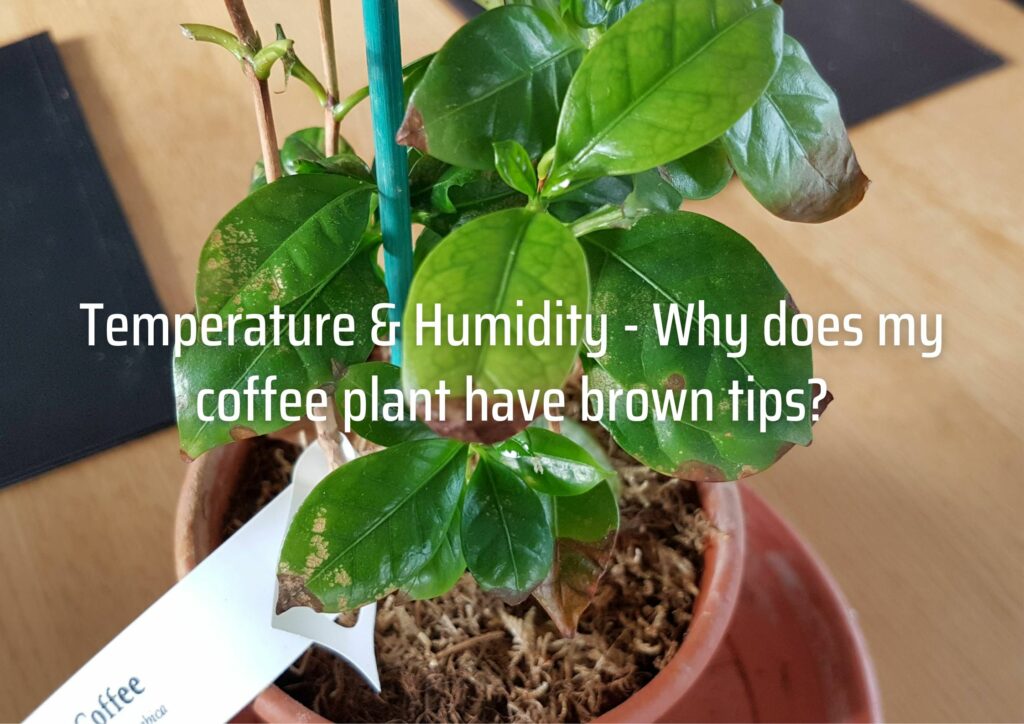How do you care for an indoor coffee plant? Can coffee plants be grown indoors?

You don’t need to know much about how to grow coffee indoors. Grab a cup of coffee and take a look at the information we have collected. Coffee can grow on trees, but it is actually on large, glossy evergreen shrubs. One of these could grow to 7 feet indoors. This one is for you if you like your houseplants large and shiny. Even though your coffee plants won’t produce enough beans to make a substantial difference in your grocery bills, they can be cared for easily. Your shrub might even produce fragrant white flowers. This could change the meaning of “wake up and smell coffee”. Here are the coffee plant care tips.
It is an easy way to honor your morning coffee – the coffee plant is the same plant that produces coffee beans! The coffee plants are a beautiful addition to any home. They have super-shiny leaves, and a dense, bushy, and upright appearance. This plant is native to Ethiopia and can be easily cared for as a houseplant. To ensure the best possible results for your coffee plant, there are some guidelines you need to follow.
Coffee plant outside in the summer.
You can give your coffee plant a summer break outdoors. However, it is fine to place it in full shade for the first few weeks to allow it to become more comfortable in the sun. After two weeks, it can be moved into the sun. You should not let the pot dry too much, especially during the summer heat, and ensure that it is placed somewhere the wind will not blow it over. It should be brought indoors as soon as the temperatures drop in the fall.
Types Of Coffee Plant – How tall does a coffee plant get?
There are two types of coffee plants: the Arabic ( Coffea Arabica) or the robusta ( Coffea Canephora), but Arabian is considered to be the best. It is a native of Ethiopia and Sudan. It prefers to grow under other trees. Robusta, which is a native of western Africa, is more resistant to heat and sun but has a bitter taste.
Both varieties can be grown in USDA Zones 10-12. Coffee plants reach 3-4 years of age and begin to produce white flowers in the leaf axils. Then, oval fruits appear. It takes 7 to 9 months for them to turn from green to yellow to red. Each fruit contains two beans. Depending on the variety of coffee you are growing, there will be different directions.
- Coffea Arabicica: Arabian coffee can grow to approximately 15 feet outside with glossy leaves up 6 inches in length.
- Coffea arica Nana’: This dwarf cultivar is often used indoors and can grow to flower and bear fruit at three feet.
- Coffea Canephora Robusta coffee can reach 12 feet high outdoors and have quilted leaves up to one foot in length.
Selection of Soil for Coffee Plants
A coffee plant indoors needs acidic, humus-rich soil that has a pH of between 5.0 to 6.0. Although a potting mix for acid-loving plants is ideal, it’s not always available. Mix equal amounts of standard potting mix and sphagnum peat moss to make your own.
Cactus and the citrus potting mix should also work as they are slightly acidic. This type of soil drains quickly and needs to be watered more often if it is chosen.
Plant at least three to five seedlings in one pot for the best look. You can also pinch one plant back often to encourage it to grow more.
Do coffee plants need sun?
Remember that an Arabian coffee plant will prefer partial sun, filtered sunlight, or bright indirect lighting when grown at home. It is best to place the plant near an east-facing window, as its panes will only receive the hottest morning rays. You could also place the plant near a south-facing window and put a sheer curtain between the curtain and the glass to filter out the sun.
Robusta coffee can also be grown in full sunlight in a south-facing, uncovered window. Most coffee shrubs that are sold as houseplants seem to be of the Arabian variety. Place yours in the bright shade under a tall tree with no low-hanging branches if you plan to move it outdoors during summer.
- Your coffee plant, like most tropical houseplants, needs indirect, bright light. Although they can tolerate some direct sunlight, too much sun will cause them to become brittle.
- Move your coffee plant away from windows with intense sunlight. You can also use a sheer curtain to diffuse light during the hottest times of the day.
- To keep your coffee plant bushy, you can trim it as the plant grows.
Watering Coffee Plants – How often should I water my coffee plant?
To prevent calcium from affecting the pH of your potting soil, use tap water to irrigate coffee plants. The soil should be kept moist, but not too wet, during spring and summer, and let it dry out more in autumn and winter. Coffee has shallow roots, so don’t allow it to dry too much. After resuming your regular watering, the soil will dry out and encourage plants to flower in spring.
You might notice brown spots on your leaves that aren’t growing well. You might be overwatering your plant if you notice browner spots.
- Coffee plants do not like to be wet so water once every 1 to 2 weeks.
- Allow the potting mixture to dry halfway between waterings. Water your plants more frequently in brighter lighting and less often under lower lights.
- Before you give it a drink, make sure to poke your finger into the soil to verify the moisture level. Make sure the pot is well-drained.
- Then, pour out excess water from the saucer. Yellowing leaves with a mushy bottom are a sign that you have overwatered. You may be not watering enough if leaves curl up and wilt.
Fertilizing Coffee Plants – What is the best fertilizer for coffee plants?
A coffee plant should be fed every other week during spring and summer. Use a plant food that is acid-loving (such as 30-10-10), at the same rate as houseplants, which is usually about 1/2 teaspoon per gallon. It is best to not fertilize it in fall or winter if the growth slows down. You might be feeding too many leaves if the edges turn brown.
If that happens, you can “wash” the soil using clean water. Just pour water into the pot and let it run out of the drainage holes. When the water stops dripping, drain the remaining water from the saucer.
Coffee trees require a lot potash, lots of nitrogen and a bit of phosphoric acid. You should apply the fertilizer to a circle around each coffee tree. But be careful not to get any on the trunk, branches, or leaves. The fertilizer can cause the coffee tree to burn if you do.
Temperature & Humidity – Why does my coffee plant have brown tips?

Coffea Arabicicaplant care needs to be done in cool, humid conditions with temperatures between 64-72 degrees Fahrenheit. Robusta plants prefer temperatures between 72 and 79° Fahrenheit. Both types might start dropping leaves at temperatures below 55°F, so it’s important to bring them indoors in the autumn. They are not able to tolerate frost or cold drafts.
You can help increase the moisture level of your plant by placing it in a humidity tray which is highly rated on Amazon. Keep it moist with rainwater or bottled water to avoid hard water spots. The leaves are not getting enough humidity if they have brown tips.
Your plant will start to grow healthy, new foliage once you address the browning of its leaves. You can trim the brown parts of the leaves with a pair of scissors, without causing any harm to the plant.
Coffee Plant Propagation
You can grow your coffee plant using unroasted coffee beans less than three months old. Let the beans soak in warm water for at least 2 days before you sow them. Place them flat side down in a 1/2-inch thick pot of damp, sterile seed-starting mixture.
To keep the coffee mix moist, wrap the pot in a plastic bag and place it where it will receive bright indirect sunlight and maintain a temperature between 72 and 77°F. Coffee beans will usually take between 1 and 3 months to sprout.
Are coffee plants toxic to dogs? Are coffee plants toxic to humans?
Coffee beans can cause skin and respiratory problems in people who have sensitive skin. However, this is usually not true for those working in the coffee industry. The beans can be potentially dangerous for pets because they contain high levels of caffeine, which can lead to hyperactivity, seizures, and cardiac problems.
Beans can also have an adverse effect on children, particularly small children. To be safe, you should keep the plant away from your pets and your children, especially when it’s fruiting. It is possible to get caffeine from coffee leaves. However, it is more common in young than in old leaves.
Coffee plants can contain caffeine and other substances that are harmful to pets. You may have a nibbler or are unsure if your pet enjoys eating houseplants. Place your coffee plant out of reach of your pet. If your pet is chomping on your coffee plant, immediately call your veterinarian.
Potential Diseases and Pests
The most common pests in coffee plants are mealybugs. These bugs may appear as bits of white cottony dust that stick to the plant’s glossy leaves. You should be able to wipe them off with a cotton swab soaked in rubbing alcohol.
Sunburn is another common problem caused by foliage being exposed to too brighter light. This can lead to yellowed leaves that eventually turn brown. You can prevent this by gradually moving the plant to a sunny position rather than doing it all at once.
